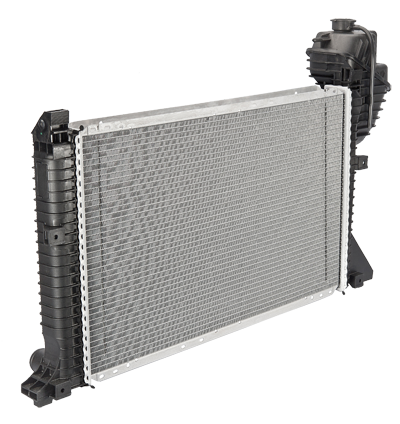Need expert San Diego radiator repair? An overheating engine isn’t something to ignore. If your dashboard temperature gauge is reading high, you see a leak, or you smell coolant, it’s time to take action.
Pacific Automotive, located near Pacific Beach and La Jolla, specializes in complete cooling system diagnosis and repair. Don’t wait until you’re stranded with steam coming from under the hood. Delaying radiator repairs can lead to severe engine damage, sometimes beyond repair.
Signs You Need Cooling System Service

Be aware of these common warning signs. If you notice any of them, it’s time to see a mechanic.
- High-Temperature Gauge: The most obvious sign your car is overheating.
- Puddles Under Your Car: Coolant is often bright green, pink, or orange.
- Sweet “Maple Syrup” Smell: This is the distinct scent of leaking antifreeze.
- Grinding Noise: This can indicate a failing water pump.
- Visible Steam: If you see steam from the engine bay, pull over immediately once it’s safe.
- Low Coolant Levels: Constantly having to top off your coolant means you have a leak.
- Muddy or Brown Coolant: When you check your coolant, it should be a bright color (like green or pink). If it’s brown, rusty, or muddy, it’s old and needs to be flushed.
Safety Note: An overheated radiator is under pressure. Never try to remove the radiator cap until the engine has had plenty of time to cool down completely.
Simple Checks You Can Do
- Check Hoses: Visually inspect the radiator hoses for any wear, cracks, or cuts.
- Check Overflow Tank: When the engine is cool, check that the liquid level in the overflow tank is between the “low” and “full” lines.
San Diego Summers Put Your Radiator to the Test
In Southern California, a pre-summer check-up is always a good idea. Just the 120-mile trip up Highway 5 to Los Angeles can put a huge strain on your car’s radiator, let alone a trip inland to Palm Springs (139 miles) or Las Vegas (332 miles). Considering our climate, a cooling system inspection is a good idea regardless of your travel plans.
Your ASE-Certified Radiator Experts in San Diego
Whatever your cooling system problem, visit us before you find yourself stranded. Pacific Automotive has served San Diego for over 20 years, with ASE-certified master mechanics for all your automotive needs.
We are your affordable San Diego dealership alternative. Our scheduled maintenance and repair services maintain your manufacturer’s warranty and keep your vehicle performing reliably long after. Our customers love our technical expertise, affordable rates, and personal attention. We guarantee your satisfaction.
Complete Radiator & Cooling System Services
Our experienced technicians will identify the actual problem before we start any repairs, saving you time and money.
What is the Cooling System?
The radiator is the most critical part of the system, dumping heat from the engine. A water pump circulates coolant (antifreeze) from the engine to the radiator and back. A cooling problem could be the radiator itself, a coolant leak, the water pump, a fan belt, the cooling fan, or the thermostat.
“Antifreeze” does more than just lower the freezing point—it also raises the boiling point to prevent boil-overs. More importantly, it contains crucial anti-corrosion additives that protect seals, bearings, and metal components from rust and degradation. Coolant also coolant also lubricates the water pump and is used to heat the passenger cabin.
Drain and Flush
Failing to follow your manufacturer’s maintenance schedule can cause contaminants, sludge, and debris to build up. A drain and flush service can often take care of this. We’ll also perform a pressure test for leaks and thoroughly inspect all hoses, belts, fans, the water pump, and the thermostat. A simple pH test can measure the coolant’s acidity to determine if it needs replacing.
Radiator Repairs
Sometimes a fix is as simple as replacing the radiator cap, tightening a fan belt, or replacing a thermostat or hose.
Rebuilding and Recoring
Rebuilding involves removing and disassembling the radiator, re-soldering channels, and re-coating the frame. If the core (the main finned part) is in poor condition, “recoring” replaces it with a new one as part of the rebuild.
Radiator Replacement
In some cases, it may be more economical to simply replace the entire radiator with a new unit.
Related Repairs
Often, a cooling system problem can involve other parts, such as:
- Water Pump
- Hoses and Hose Clamps
- Thermostat
- Heater Core (part of your A/C and heat system)
- Head Gasket or Intake Manifold Gasket (a more serious leak)
TIP: Don’t use plain water to refill the radiator unless it’s an emergency. Proper coolants contain essential compounds to protect the system. If you ever must add water, use distilled water only. Using hard tap water can lead to scale build-up, which reduces cooling efficiency and can damage the system.
Using the wrong type/color of coolant is dangerous because using the wrong coolant can void the warranty.
Modern coolants use different formulas (like ethylene glycol vs. less-toxic propylene glycol). Using the wrong one can damage your system or void a warranty. We always use the specific type your manufacturer requires.
Get Your Radiator Fixed Today
Don’t risk a breakdown or expensive engine damage. Our team is ready to diagnose and repair your cooling system to keep you safe on the road.
Call us at (858) 483-1565 or schedule your service online!
